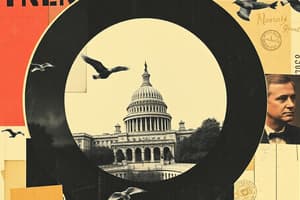Podcast
Questions and Answers
Which of the following is a measure of overall economic well-being for the United States?
Which of the following is a measure of overall economic well-being for the United States?
- Unemployment Rate
- Interest Rates
- GDP Growth (correct)
- Inflation Rate
According to Keynes, what is necessary at times?
According to Keynes, what is necessary at times?
Government intervention in the economy
Keynes and classical economists agree that government intervention should be used to correct business cycles.
Keynes and classical economists agree that government intervention should be used to correct business cycles.
False (B)
What does aggregate demand refer to?
What does aggregate demand refer to?
Ceteris paribus, based on the aggregate demand curve, if the price level _______ the quantity of real output _______ increases.
Ceteris paribus, based on the aggregate demand curve, if the price level _______ the quantity of real output _______ increases.
According to the real balances effect, when the price level falls, what happens?
According to the real balances effect, when the price level falls, what happens?
Which effect suggests that lower average prices stimulate more borrowing?
Which effect suggests that lower average prices stimulate more borrowing?
What is an increase in the average level of prices of goods and services known as?
What is an increase in the average level of prices of goods and services known as?
What should policy makers do during a recession according to Keynes?
What should policy makers do during a recession according to Keynes?
If an economy is experiencing a recession, what is the Keynesian approach to achieving full employment?
If an economy is experiencing a recession, what is the Keynesian approach to achieving full employment?
How is the short-run aggregate supply curve described?
How is the short-run aggregate supply curve described?
Ceteris paribus, based on the aggregate supply curve, if the price level _______ the quantity of real output _______ increases.
Ceteris paribus, based on the aggregate supply curve, if the price level _______ the quantity of real output _______ increases.
Which of the following is likely to cause a leftward shift in the aggregate supply curve, ceteris paribus?
Which of the following is likely to cause a leftward shift in the aggregate supply curve, ceteris paribus?
If the stock market plunged over the next week, what would consumers likely do?
If the stock market plunged over the next week, what would consumers likely do?
When is the aggregate demand curve most likely to shift to the right?
When is the aggregate demand curve most likely to shift to the right?
If an economy is experiencing a recession, what is the classical approach to achieving full employment?
If an economy is experiencing a recession, what is the classical approach to achieving full employment?
Who controls monetary policy?
Who controls monetary policy?
Which of the following causes the aggregate supply curve to shift to the left, ceteris paribus?
Which of the following causes the aggregate supply curve to shift to the left, ceteris paribus?
Study Notes
Economic Indicators and Theories
- GDP growth serves as a measure of overall economic well-being in the United States.
- Keynes argued that government intervention is sometimes necessary to stabilize the economy.
Differences Between Economic Schools
- Keynesian and classical economists differ on the necessity of government intervention to correct business cycles.
Aggregate Demand
- Aggregate demand encapsulates the combined behavior of all buyers within the economy.
- According to the aggregate demand curve, ceteris paribus, a decrease in price level results in an increased quantity of real output demanded.
Price Level Effects
- The real balances effect explains that a fall in price level increases the value of cash, leading to higher consumption.
- The interest rate effect indicates that lower average prices encourage more borrowing.
Inflation and Economic Policy
- Inflation is defined as the increase in the average price level of goods and services.
- Keynes suggested policymakers should cut taxes or increase government spending during a recession to stimulate the economy.
- The Keynesian approach to achieving full employment in a recession promotes tax cuts or increased government spending.
Aggregate Supply Dynamics
- The short-run aggregate supply curve is characterized as upward sloping to the right.
- An increase in price level, ceteris paribus, leads to an increase in the quantity of real output produced.
- Factors such as an increase in the cost of natural gas can shift the aggregate supply curve to the left.
- A decrease in stock market value leads consumers to demand fewer goods and services.
Aggregate Demand Shifts
- A decrease in taxes typically shifts the aggregate demand curve to the right.
Classical Economic Approach
- The classical response to a recession is to refrain from intervention and allow natural market forces to restore full employment.
Monetary Policy
- The Federal Reserve is responsible for controlling monetary policy in the economy.
- An increase in labor costs can also lead to a leftward shift in the aggregate supply curve.
Studying That Suits You
Use AI to generate personalized quizzes and flashcards to suit your learning preferences.
Description
Test your knowledge with these flashcards covering key concepts from Chapter 11 of ECON100. The questions focus on economic well-being, government intervention, and the differing views of Keynes and classical economists. Perfect for preparing for your exam!




